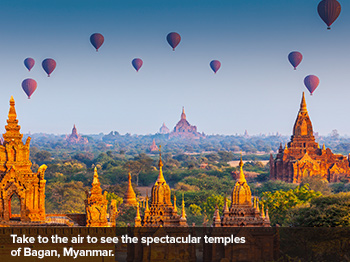When Bagan, once the capital of what is now Myanmar (formerly Burma), was at the height of its power, from the 11th to the 13th century, its rulers built more than 10,000 religious monuments within a 19-square-mile grid. Unlike houses at that time, presumably assembled from wood, mud and thatch, these temples, made of mortar and hand-stamped bricks, were built to last. And survive they have, through Mongol invasions, countless regime changes and years of pillaging and neglect. Today, more than 2,000 of these structures still exist, many topped with ornate spires and detailed carvings. A few house original Buddhist and Hindu icons.
MARKET DAYS
This magical landscape continues to be the heartbeat of Bagan. While tourists snap pagoda-facing selfies, city residents treat it like a communal backyard, growing crops like corn and winter melon among the monuments. They sell them and other goods—longyi, or traditional skirts worn by men and women, and thanaka, a powdery makeup unique to the region—at Bagan’s daily downtown market. This web of stalls is a great spot to find souvenirs like paper umbrellas and toy puppets.
VIEWS FROM THE TOP
One of the best ways to see Bagan’s temples and pagodas is from above. A hot-air balloon ride with Balloons over Bagan is worth the splurge; opt for a ride at sunrise, when the cooler temperatures allow the balloon to get closer to the ground. Average flight times are 45 minutes to an hour. Afraid of heights? Rent a bike—they’re available from most hotels—and meander on the dirt paths that connect the temples. Be sure to climb up Shwesandaw Pagoda, one of the tallest in the bunch, for its 360-degree landscape views, and visit the Ananda Temple, built in A.D. 1091, to see its four massive golden Buddha statues.

HAUTE HOTELS
Of all of Myanmar’s travel-friendly destinations, Bagan has some of the best hotels. At the 85-room Bagan Lodge, stay in a suite that overlooks the 65-foot lap pool surrounded by umbrellas and lounge chairs. The Aureum Palace Hotel, which is located on the temple preservation grounds and built in the spirit of the landscape, with a brick facade and ornate rooftops, has 114 rooms, as well as a spa and an art gallery.
LIFE ON THE RIVER
Bagan sits on the Ayeyarwady River, the country’s largest waterway and its lifeline. The city is the starting point for a few top-notch river cruises, such as Abercrombie & Kent’s new Sanctuary Ananda, which makes three- to seven-night trips throughout the region and spends two days in Bagan. Each of the boat’s 21 staterooms have outdoor balconies, and Sumet Sumpachanyanot, formerly the chef at the Mandarin Oriental Bangkok, cooks up delicious Thai and Burmese-inspired dishes—garlicky pork with chilies; shrimp and lemongrass salad—for lunch and dinner. The vessel also stops in the small village of Sin Kyun, home to a community of peanut farmers, and in Amarapura, where travelers jump in wooden boats and sail under the teak U Bein Bridge.
The Details
Ananda Temple: Nyaung U, Bagan
Aureum Palace Hotel: Min Nanthu Village, Nyaung Oo; 011-95-6160-0467; aureumpalacehotel.com;
Bagan’s downtown market: Nyaung-U, Bagan
Bagan Lodge: Myat Lay Rd., New Bagan, Nyaung Oo Township; 011-95-616-5456; bagan-lodge.com;
Balloons Over Bagan: 011-95-124-8907; balloonsoverbagan.com
Sanctuary Ananda: 630-725-3449; sanctuaryretreats.com
Shwesandaw Pagoda: Nyaung-U, Bagan
NOTE: Information may have changed since publication. Please confirm key details before planning your trip.